What Are the Key Differences in Nesting Habits Among Parrot Species?
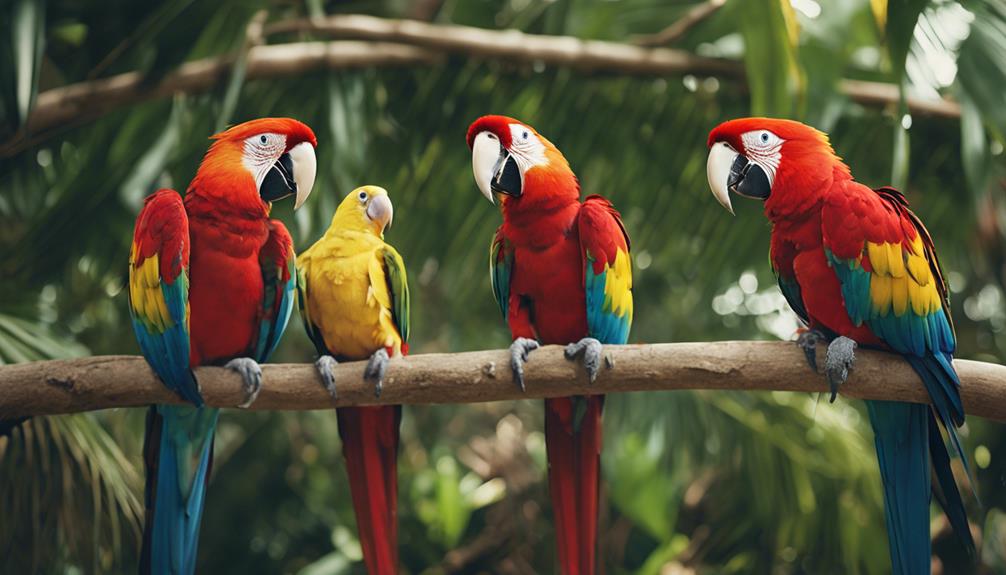
Parrots are known for their diverse nesting habits, with different species exhibiting unique preferences for nest locations and structures. Some parrot species, such as macaws, prefer to nest high up in large tree cavities, while others, like cockatoos, nest in tree hollows closer to the ground.
These nesting habits can also vary based on environmental factors and food availability. For example, some parrots may choose to nest in cliffs or burrows if suitable tree cavities are scarce. Additionally, the size and composition of the nesting material can differ among species, with some parrots using leaves and twigs while others use feathers and fur.
Understanding these differences in nesting habits is crucial for conservation efforts, as preserving suitable nesting sites is essential for the survival of parrot populations. By studying the varied ways in which parrots choose their nests, researchers can better inform conservation strategies to protect these beloved birds.
Tree Hollow Nesting
Tree-dwelling parrot species exhibit a preference for nesting in natural tree hollows, utilizing these cavities for shelter and breeding purposes. When it comes to nesting height variation, different parrot species show particular preferences. For instance, the colorful Blue-and-yellow Macaw tends to select nesting sites at greater heights compared to the Crimson Rosella, which favors lower nest locations. This variation in nesting height selection could be attributed to factors such as predator avoidance, microclimate differences, or even competition with other bird species.
In terms of tree cavity selection, parrots demonstrate a keen eye for specific features when choosing their nesting sites. They often favor cavities with narrow entrances, which provide better protection against potential predators. Additionally, the orientation of the tree hollow plays a crucial role, with parrots showing a preference for cavities facing away from prevailing winds or with an eastern exposure to benefit from the morning sun. These intricate choices in tree cavity selection highlight the adaptive nature of parrot species in optimizing their nesting environments for successful breeding outcomes.
Ground Burrow Nesting
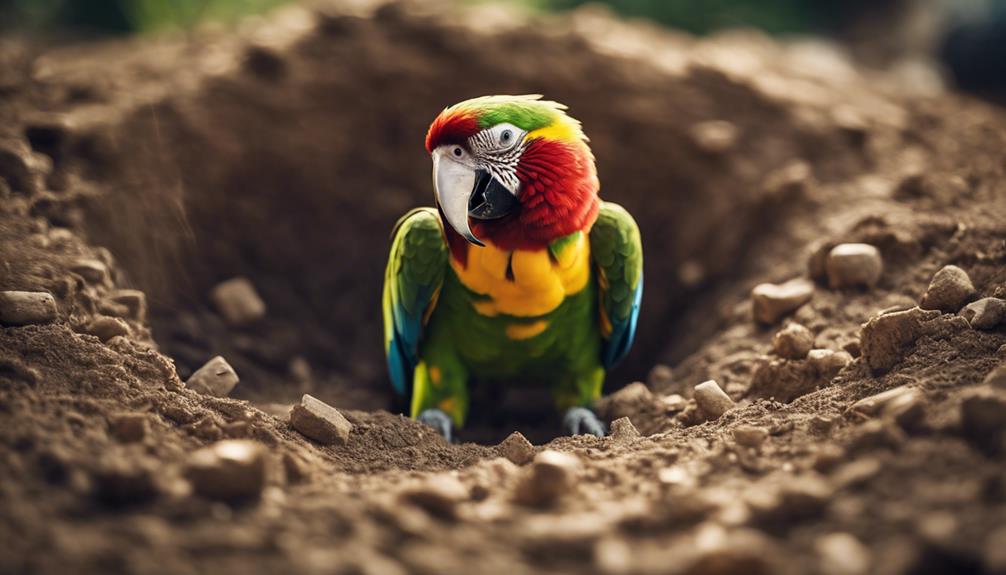
Ground burrow nesting among parrot species varies significantly in terms of burrow size, with some species excavating larger tunnels than others. These birds also exhibit distinct preferences for nesting materials, with some favoring leaves and twigs while others opt for softer materials like feathers and fur.
Additionally, parental care behaviors differ among parrot species that engage in ground burrow nesting, showcasing unique strategies for protecting and nurturing their offspring.
Burrow Size Differences
When considering nesting habits among parrot species, one notable variation lies in the size differences of burrows utilized for ground burrow nesting. Parrots exhibit diverse behaviors in constructing and selecting burrows based on various factors such as mate selection and predator avoidance.
Here are key points regarding burrow size differences:
- Species Specificity: Different parrot species construct burrows of varying sizes tailored to their specific needs.
- Mate Attraction: Larger burrows may play a role in attracting potential mates during the breeding season.
- Nesting Success: The size of the burrow can impact the success rate of nesting and raising offspring.
- Temperature Regulation: Burrow size may influence temperature regulation within the nesting site.
- Predator Protection: Smaller entrances can serve as a defense mechanism against predators, ensuring the safety of the nesting pair and their young.
Nesting Material Preferences
Nesting material preferences among parrot species engaging in ground burrow nesting significantly impact their nesting behaviors and reproductive success. When selecting nesting sites, these species show a preference for locations with abundant nesting material availability.
The architecture of their nests is influenced by the types of materials they can access, with some species opting for softer materials like leaves, while others prefer sticks and twigs. Nest location preferences also play a crucial role, with parrots often favoring areas where suitable materials are within close reach.
Understanding these preferences is essential for conservation efforts and providing suitable nesting environments for ground burrow nesting parrot species. By ensuring access to preferred nesting materials, conservationists can help support the reproductive success of these unique birds.
Parental Care Behaviors
Parental care behaviors in ground burrow nesting parrot species exhibit a diverse range of strategies to ensure the well-being of their offspring. These behaviors are crucial for the survival and development of the chicks.
Some key aspects of parental care in ground burrow nesting parrots include:
- Feeding Routines: Parents meticulously feed their chicks with regurgitated food, ensuring they receive proper nutrition for growth.
- Communication: Adults use specific calls and vocalizations to communicate with their mate and chicks, establishing bonds and coordinating care duties.
- Mating Rituals: The pair bond between parents is strengthened through elaborate courtship displays and rituals before and during the breeding season.
- Chick Development: Parents monitor the growth and development of their chicks closely, adjusting care behaviors as the chicks mature.
- Nurturing Environment: Adults create a safe and comfortable environment within the burrow to protect their offspring from predators and harsh weather conditions.
Cliffside Nesting
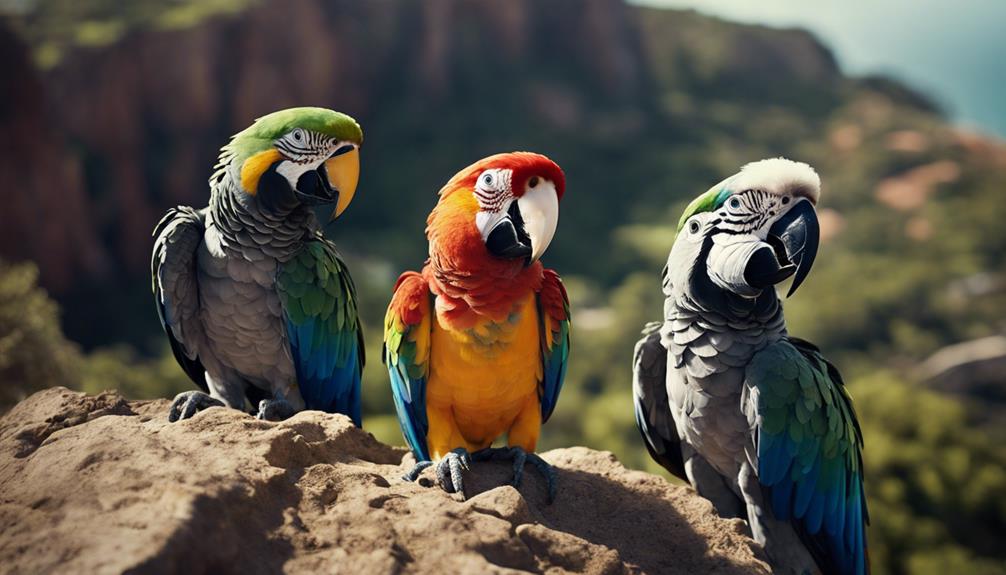
Perched precariously along rugged cliff faces, parrot species with cliffside nesting habits demonstrate remarkable adaptability to their unique environments. These birds face various challenges and dangers when selecting and maintaining their nesting sites on cliffs. The selection process for a suitable cliffside nesting site involves factors such as protection from predators, accessibility, and structural stability. Despite the risks, cliffside nesting offers several advantages for parrot species.
| Cliffside Nesting Dangers | Nesting Site Selection |
|---|---|
| Predation risk from aerial predators | Protection from predators |
| Exposure to harsh weather conditions | Accessibility to the site |
| Potential for nest collapse | Structural stability |
| Limited escape routes in case of danger | Camouflage opportunities |
| Difficulty in accessing food sources | Availability of nesting materials |
To thrive in such extreme habitats, parrots have evolved remarkable adaptations. These adaptations include strong feet for gripping onto rocky surfaces, excellent flying skills for navigating cliff environments, and the ability to withstand strong winds. The advantages of cliffside nesting include increased protection from ground-based predators, reduced competition for nesting sites, and panoramic views that aid in detecting approaching threats.
Cavity Nesting
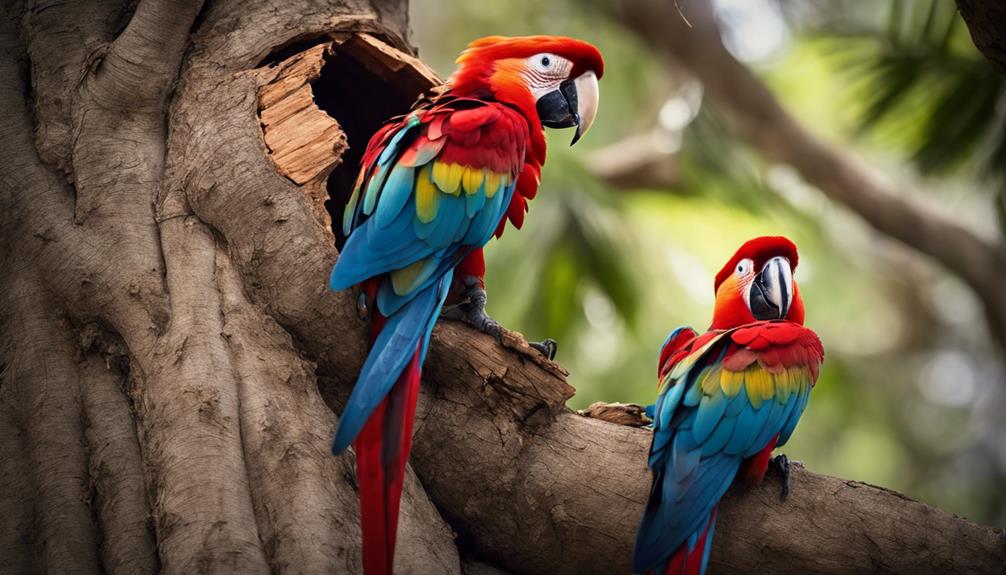
Adapting to the availability of natural cavities, parrot species exhibit diverse nesting behaviors within these enclosed spaces. Nesting site selection is a crucial factor influencing breeding success in cavity-nesting parrots.
The following points shed light on the significance of cavity nesting in parrot species:
- Nesting Site Selection: Parrots meticulously select cavities based on various factors such as cavity size, location, and accessibility, ensuring optimal conditions for raising their young.
- Breeding Success: The choice of cavity profoundly impacts breeding success, as it influences the safety and protection of the nestlings from predators.
- Cavity Size: Different parrot species show preferences for specific cavity sizes, with some species favoring larger spaces to accommodate their nesting needs adequately.
- Predator Protection: The enclosed nature of cavities provides a natural shield against predators, enhancing the chances of successful breeding and fledging of offspring.
- Behavioral Adaptations: Parrots exhibit unique behavioral adaptations when nesting in cavities, such as vocal communication to defend their nesting site and cooperative breeding efforts to raise their young successfully.
Arboreal Nesting
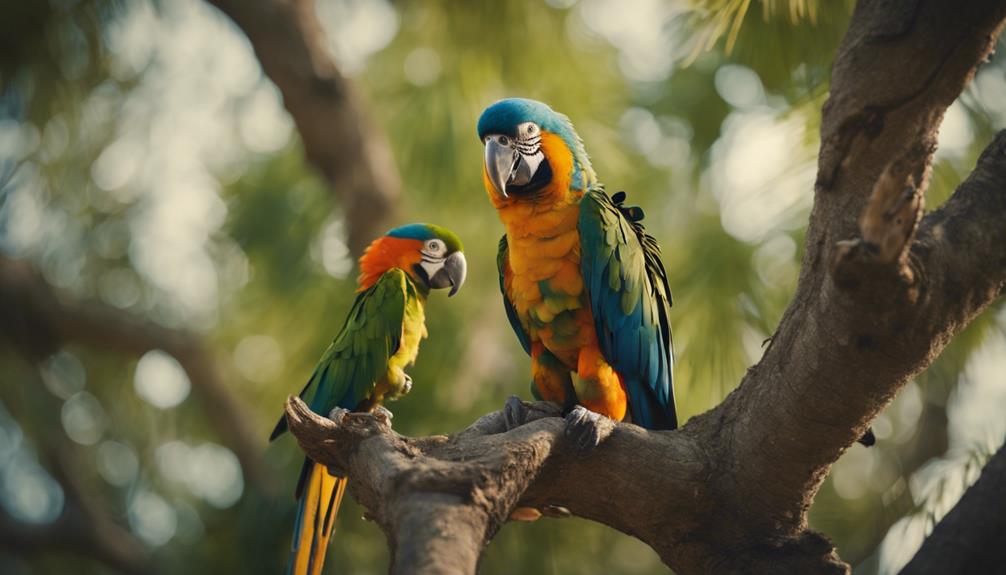
Arboreal nesting, commonly observed among various parrot species, involves the selection and utilization of tree cavities or natural crevices for breeding purposes. Parrots that exhibit arboreal nesting behavior often choose nesting heights within the canopy of trees, providing them with protection from ground predators and other potential threats. These birds typically rely on the shelter provided by tree bark or existing tree hollows to establish their nests.
When constructing their nests, arboreal nesters utilize a variety of nesting materials such as twigs, leaves, and feathers. The female parrot takes the lead in nest preparation, arranging the materials within the chosen cavity to create a suitable environment for laying eggs and raising offspring. The male may assist in gathering nesting materials or defending the nest site.
Arboreal nesting habits vary among parrot species, with some preferring to nest in densely wooded areas while others may choose trees located near water sources. Understanding these behaviors is crucial for conservation efforts aimed at protecting parrot populations and their nesting habitats.
Colony Nesting
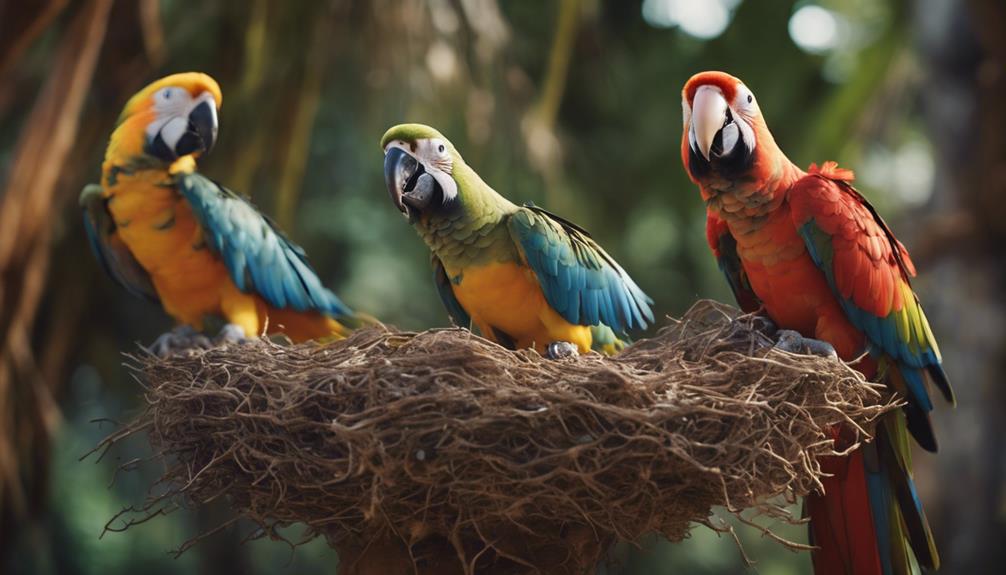
Parrot species that engage in colony nesting exhibit a unique social structure where multiple individuals work together to construct a communal nest. This group effort in nest building allows for the sharing of nesting responsibilities, such as egg incubation and chick rearing, among colony members.
Group Nest Building
During the breeding season, many parrot species engage in group nest building, also known as colony nesting, to enhance protection and increase reproductive success. This behavior is influenced by social dynamics and environmental factors.
- Enhanced Security: Group nest building helps deter predators due to the larger number of individuals guarding the nests.
- Resource Sharing: Parrots in a colony can share food and help each other with chick rearing duties.
- Increased Reproductive Success: The collective effort in nest construction and defense increases the chances of successful breeding.
- Social Bonding: Group nest building fosters social bonds among colony members, essential for long-term survival in the wild.
- Learning Opportunities: Younger parrots in the colony can observe and learn vital skills from experienced nest builders.
Shared nesting responsibilities in parrot colonies involve a collaborative effort among individuals to collectively construct and defend nests, ensuring the safety and successful breeding of the group.
Nesting site selection is a crucial initial step, often involving both mates in the decision-making process. Once the nest is established, parrots exhibit a division of labor in caring for their offspring. This division includes specific roles such as taking turns during incubation shifts and sharing feeding duties.
Both male and female parrots actively participate in these tasks, showcasing a high level of cooperation within the colony. This shared responsibility not only strengthens the bond between mates but also enhances the overall reproductive success of the group.
Nesting Platform Construction
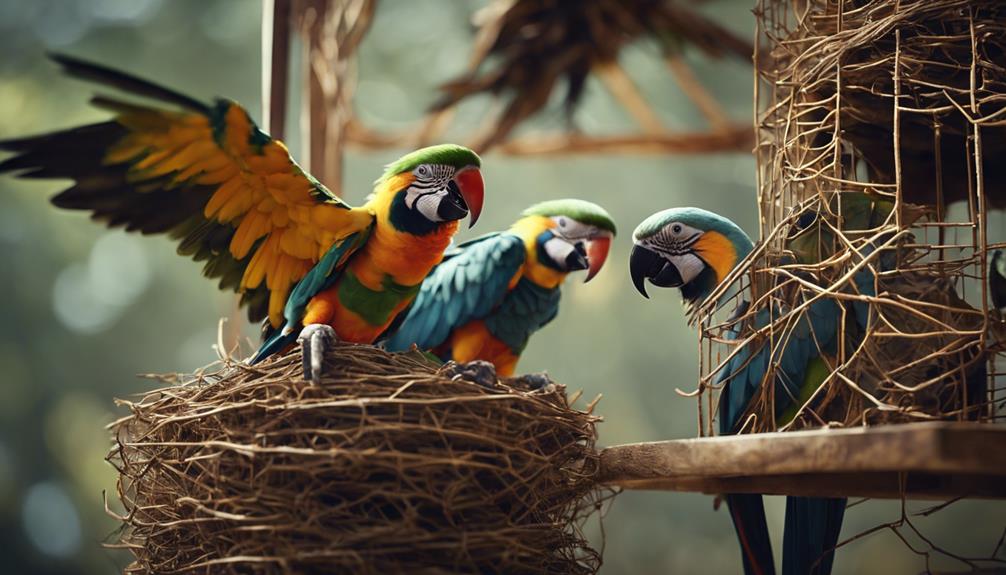
Constructing platforms for nesting is a crucial behavior observed in various parrot species, showcasing distinct preferences and techniques. When it comes to nesting platform construction in parrots, several key factors influence their choices and methods:
- Nesting Material Types: Different parrot species exhibit preferences for specific nesting materials, ranging from twigs and leaves to bark and feathers. The choice of material can impact the durability and stability of the nesting platform.
- Durability of Nesting Materials: Parrots often select materials that are resilient and long-lasting to ensure the structural integrity of their nesting platform over time.
- Nesting Platform Stability: Parrots prioritize stability when constructing nesting platforms to provide a secure environment for their eggs and young.
- Nesting Platform Height: The height at which parrots build their nesting platforms varies among species, with some preferring elevated locations for added protection.
- Adaptation to Environmental Conditions: Parrot species adapt their nesting platform construction techniques based on the specific environmental challenges they face, such as strong winds or predators.
Frequently Asked Questions
Do Parrot Species Exhibit Any Unique Behaviors or Adaptations When It Comes to Selecting Their Nesting Sites?
Parrot species display unique behaviors in selecting nesting sites. They carefully choose nesting materials for camouflage. Some prefer cavity nesting for protection, while others meticulously select trees. These adaptations ensure their young are safe and secure.
How Do Parrot Species Defend Their Nests and Young From Potential Predators or Competitors?
Parrot species employ various nesting strategies to defend their nests and young from predators. They exhibit strong parental care and use aggressive behaviors, like loud calls and physical attacks, to protect their nests.
Are There Any Specific Environmental Factors That Influence the Nesting Habits of Different Parrot Species?
Climate effects play a crucial role in shaping parrot species' nesting behavior. From rainforest dwellers to desert inhabitants, each adapts their habitat preferences and nesting sites to suit environmental conditions. These factors greatly influence their nesting habits.
Do Parrot Species Show Consistency in Their Nesting Habits Year After Year, or Do They Adapt to Changing Conditions?
Like architects designing unique homes, parrot species exhibit varying nesting habits. They display both consistency in nesting site selection for reproductive success and adaptability to changing climates for environmental changes, showcasing their ability to thrive amidst diversity.
Are There Any Known Instances of Parrot Species Exhibiting Cooperative Nesting Behaviors With Other Bird Species?
In some instances, parrot species exhibit interspecies cooperation in nesting behaviors. This unique phenomenon involves social nesting where parrots may team up with other bird species for mutual benefit, showcasing fascinating behavioral adaptations in the avian world.











